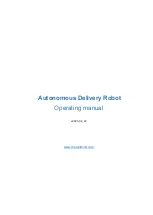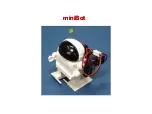
4
Programming manual for Meca500 (for firmware 9.2.x)
BASIC THEORy ANd dEfINITIONS
1.1.6 Joint set and robot posture
There are several possible solutions for joint angle values, for a desired location of the robot end-
effector with respect to the robot base (i.e., several possible sets {
θ
1
,
θ
2
,
θ
3
,
θ
4
,
θ
5
,
θ
6
}). The simplest way
to describe how the robot is postured, is by giving its set of joint angles. This set will be referred to as
the
joint set
, and occasionally as
joint position
.
For example, in
, the joint set is {0°, 0°, 0°, 0°, 0°, 0°}, although, it could have been {0°, 0°, 0°, 0°,
0°, 360°}, and you wouldn't be able to tell the difference.
A joint set completely defines the relative poses (i.e., the "arrangement," of the seven robot links,
starting with the base and ending with the end-effector). This arrangement is called the
robot posture
.
Thus, the joint sets {
θ
1
,
θ
2
,
θ
3
,
θ
4
,
θ
5
,
θ
6
} and {
θ
1
,
θ
2
,
θ
3
,
θ
4
,
θ
5
,
θ
6
+
c
t
360°}, where −180° <
θ
6
≤ 180° and
c
t
is the axis 6 turn configuration, correspond to the same robot posture. Therefore, a joint set has the
same information as a robot posture AND an axis 6 turn configuration.
1.2. Configurations, singularities and workspace
1.2.1 Inverse kinematic solutions and configuration parameters
Meca500's inverse kinematics generally provide up to eight feasible robot postures for a desired pose
of the TRF with respect to the WRF (
), and many more joint sets (since if
θ
6
is a solution, then
θ
6
±
n
360°, where
n
is an integer, is also a solution). Each of these solutions is associated with one of
eight
robot posture configurations
, defined by three parameters:
c
s
,
c
e
and
c
w
. Each of these parameters
corresponds to a specific geometric condition on the robot posture (see
•
c
s
(shoulder configuration parameter):
–
c
s
= 1, if the
wrist center
(where the axes of joints 4, 5 and 6 intersect) is on the "front" side of
the plane passing through the axes of joints 1 and 2 (see
a
). The condition
c
s
= 1 is often
referred to as "front".
–
c
s
= −1, if the wrist center is on the "back" side of this plane (see
c
)
.
•
c
e
(elbow configuration parameter):
–
c
e
= 1, if
θ
3
> −arctan(60/19) ≈ −72.43° ("elbow up" condition, see
)
;
–
c
e
= −1, if
θ
3
< −arctan(60/19) ≈ −72.43° ("elbow down" condition, see
f
).
•
c
w
(wrist configuration parameter):
–
c
w
= 1, if
θ
5
> 0° ("no flip" condition, see
g
);
–
c
w
= −1, if
θ
5
< 0° ("flip" condition, see
).
shows an example all eight possible robot postures, described by the posture configuration
parameters {
c
s
,
c
e
,
c
w
}, for the pose {77 mm, 210 mm, 300 mm, −103°, 36°, 175°} of the
FRF with respect
to the BRF.
shows an example of each robot posture configuration parameter, and limit conditions, which
are called
singularities
. Note that the popular terms front/back and elbow-up/elbow-down are misleading
as they are not relative to the robot base but to specific planes that move when some of the robot joints
rotate.
Summary of Contents for Meca500 R3
Page 10: ......













































